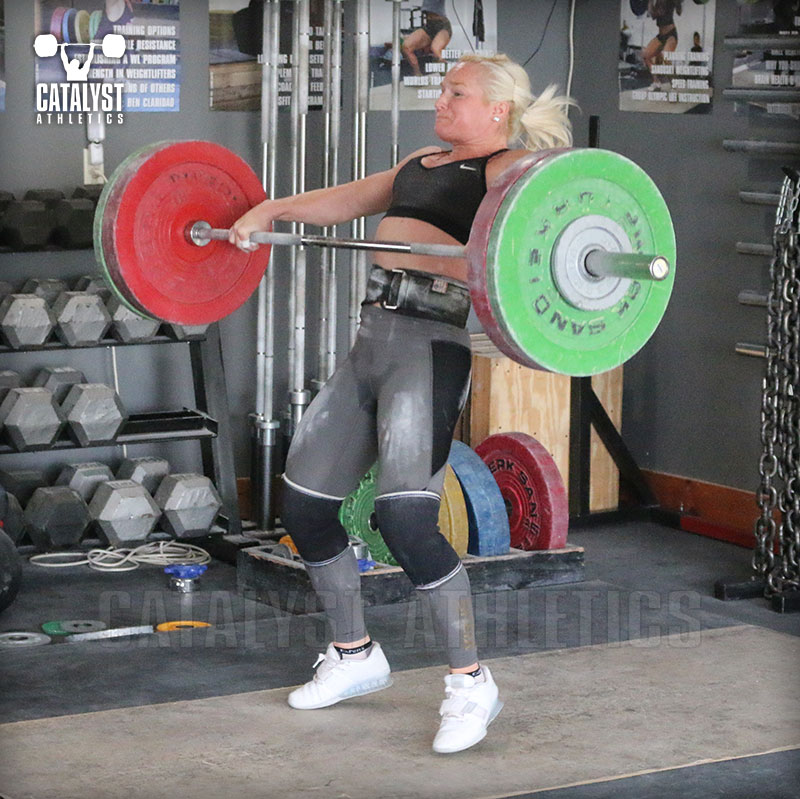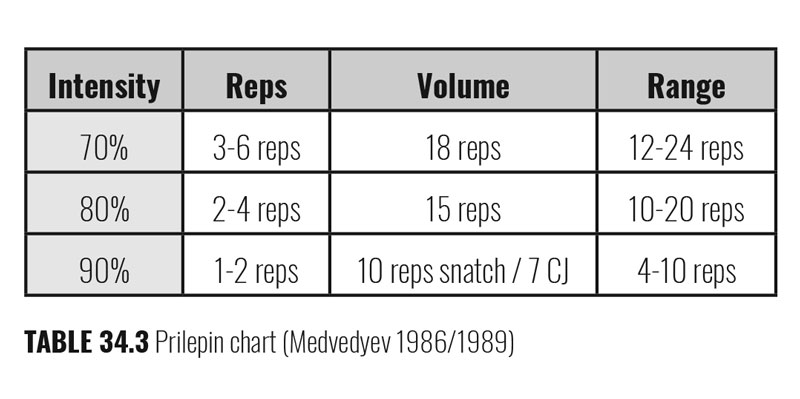Articles
Prilepin's Table for Olympic Weightlifting
October 23 2019

October 23 2019

This little table makes the rounds on the internet regularly and is a staple of some coaches’ programming… just not any weightlifting coaches I know of. The idea that it’s useful for writing programming is incomplete at best. It’s not entirely useless, but its utility is very limited. Let me explain.
First, it’s instructive to know about the chart’s origin. Soviet national coach AS Prilepin created it in 1975 by analyzing training journals of Soviet weightlifters during 2 different 5-week mesocycles. In other words, it’s descriptive, not prescriptive. It’s also based on a limited amount of time, and on fairly similar methods of training, i.e. all Soviet lifters who were training in similar manners to each other. The figures are based exclusively on the snatch and clean & jerk—they have nothing to do with squats, pulls, presses or any other exercises we all use regularly.
That information alone makes the usefulness dubious, but wait, there’s more.

The first big issue is the huge ranges of the numbers. We’re looking at 10% ranges in intensities—80% and 89% are extremely different numbers in practice… and so are 2 and 4 reps at a weight in that range. One may be easy, and one may literally be impossible for a given lifter.
Next, it doesn’t take the dramatic variation among lifters into account—technical proficiency, neurological efficiency, speed and explosiveness, training age, biological age, bodyweight or any of the other factors that determine an athlete’s needs or capacity for lifting a certain intensity a certain number of times for a certain number of sets.
We also know it’s based solely on the snatch and clean & jerk. So what about squats? Pulls? Pressing variations? How are the numbers for the snatch and clean & jerk affected based on the other exercises being done along with them? Even if we conceded it was a perfect system for prescribing training for the competition lifts, that still leaves us completely on our own for prescribing everything else we need to do.
Finally, it provides no guidance for the modulation of variables throughout a micro-, meso- or macrocycle. Are we just doing the same thing over and over indefinitely? Of course not. But how are we supposed to use this chart to progress? If we snatch 3 days each week, are we supposed to do the exact same workout each time? How are we supposed to vary intensity and reps within a week for a repeated exercise like squats, commonly done 3 or more days each week? How is training at the beginning of a mesocycle 16-20 weeks away from a competition different from a mesocycle 3 weeks away? They can’t possibly be the same.
The obvious conclusion is that even with this chart in hand, the overwhelming majority of decisions regarding intensity and volume prescriptions have to be made based on totally unrelated information and experience. And if you have that information and experience, what purpose does the chart serve?
Have a look at it once. Notice the pattern of reducing reps and volume with increasing intensity. Then move on with your life and learn more about program design, and accumulate more experience training and coaching.
First, it’s instructive to know about the chart’s origin. Soviet national coach AS Prilepin created it in 1975 by analyzing training journals of Soviet weightlifters during 2 different 5-week mesocycles. In other words, it’s descriptive, not prescriptive. It’s also based on a limited amount of time, and on fairly similar methods of training, i.e. all Soviet lifters who were training in similar manners to each other. The figures are based exclusively on the snatch and clean & jerk—they have nothing to do with squats, pulls, presses or any other exercises we all use regularly.
That information alone makes the usefulness dubious, but wait, there’s more.

The first big issue is the huge ranges of the numbers. We’re looking at 10% ranges in intensities—80% and 89% are extremely different numbers in practice… and so are 2 and 4 reps at a weight in that range. One may be easy, and one may literally be impossible for a given lifter.
Next, it doesn’t take the dramatic variation among lifters into account—technical proficiency, neurological efficiency, speed and explosiveness, training age, biological age, bodyweight or any of the other factors that determine an athlete’s needs or capacity for lifting a certain intensity a certain number of times for a certain number of sets.
We also know it’s based solely on the snatch and clean & jerk. So what about squats? Pulls? Pressing variations? How are the numbers for the snatch and clean & jerk affected based on the other exercises being done along with them? Even if we conceded it was a perfect system for prescribing training for the competition lifts, that still leaves us completely on our own for prescribing everything else we need to do.
Finally, it provides no guidance for the modulation of variables throughout a micro-, meso- or macrocycle. Are we just doing the same thing over and over indefinitely? Of course not. But how are we supposed to use this chart to progress? If we snatch 3 days each week, are we supposed to do the exact same workout each time? How are we supposed to vary intensity and reps within a week for a repeated exercise like squats, commonly done 3 or more days each week? How is training at the beginning of a mesocycle 16-20 weeks away from a competition different from a mesocycle 3 weeks away? They can’t possibly be the same.
The obvious conclusion is that even with this chart in hand, the overwhelming majority of decisions regarding intensity and volume prescriptions have to be made based on totally unrelated information and experience. And if you have that information and experience, what purpose does the chart serve?
Have a look at it once. Notice the pattern of reducing reps and volume with increasing intensity. Then move on with your life and learn more about program design, and accumulate more experience training and coaching.
